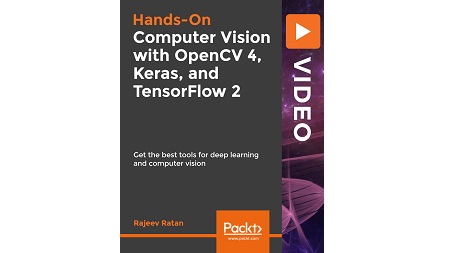
English | MP4 | AVC 1920×1080 | AAC 48KHz 2ch | 6h 07m | 1.51 GB
Build your own computer vision deep learning classifiers
Do you want to understand how computers see images and videos? Using artificial intelligence, we can enable computers and smart devices to interpret what is in an image (computer vision).
This can provide massive benefits when it comes to automating tasks for which images are vital, such as examining medical images or enabling self-driving cars to see. Already, these applications are creating a massive industry around computer vision—one that is set to grow rapidly, with some sources predicting that it will be worth over $43 billion by 2023.
This course provides you with a perfect foundation from which to understand computer vision and supports your professional development in this fast-growing arena. We first learn the basic concepts and explore these using OpenCV4, the most popular open-source computer vision library. Next, we explore using Machine Learning in computer vision, including the use of deep learning (using TensorFlow 2.0 and Keras) to implement advanced image classifiers.
This course is designed to help data scientists, and those who already have some familiarity with ML and DL (and experience with Python, Keras, and TensorFlow), to gain a solid understanding of OpenCV and train their own computer vision deep learning models.
Learn
- Image manipulations (dozens of techniques—such as transformations, blurring, thresholding, edge detection, and cropping)
- How to segment images using a variety of OpenCV algorithms, from contouring to blob and line detection
- Approximate contours and perform contour filtering, ordering, and approximations
- Perform object detection for faces, people, and cars
- Use Machine Learning in computer vision, including understanding Deep Learning models such as convolutional neural networks
- Create a varying range of image classifiers—for example, recognizing handwritten digits, gesture recognition, and other multi-class classifiers
- Perform facial recognition with deep learning
Table of Contents
Introduction to Computer Vision with OpenCV
1 Course Overview
2 Setting Up Your Computer Vision Tools (Python, OpenCV 4, TensorFlow 2.0, and Keras)
3 Image Formation and Digital Representation
4 Getting Started with OpenCV 4
5 Getting Started with OpenCV 4 – Practical
6 Understanding Color Spaces and Applying Grayscaling
7 Understanding Color Spaces and Applying Grayscaling – Practical
8 Creating and Drawing on Images with OpenCV
Image Manipulations in OpenCV Operations
9 Translations, Rotations, and Transformations
10 Scaling, Resizing, Interpolations, and Cropping
11 Scaling, Resizing, Interpolations, and Cropping – Practical
12 Arithmetic and Bitwise Operations
13 Blurring and Sharpening Images
14 Blurring and Sharpening Images – Practical
15 Thresholding, Binarization, and Adaptive Thresholding
16 Thresholding, Binarization, and Adaptive Thresholding – Practical
17 Dilation, Erosion, and Edge Detection
18 Dilation, Erosion, and Edge Detection – Practical
Image Segmentation and Object Detection in OpenCV
19 Segmentation and Contours
20 Segmentation and Contours – Practical
21 Sorting and Approximating Contours
22 Sorting and Approximating Contours – Practical
23 Line, Circle, and Blob Detection
24 Line, Circle, and Blob Detection – Practical
25 Object Detection with HAAR Cascade Classifiers
26 Face and Eye Detection
27 Car and People Detection
Machine Learning and Deep Learning in Computer Vision
28 Machine Learning in Computer Vision
29 Deep Learning and Neural Networks
30 Introduction to Convolutional Neural Networks
31 Creating a CNN Using Keras and TensorFlow 2.0
32 Loading and Preparing Image Data
33 Training Our CNN and Analyzing Performance
Deep Learning for Advanced Image Recognition, Facial Recognition, and Gesture Recognition
34 Understanding CNN Design and Training
35 Gesture Recognition Using Sign Language MNIST
36 Building Your Own Gesture Recognition System with Your Own Data
37 Facial Recognition with Deep Learning
38 Implementing VGG Face for Facial Similarity Comparison
39 Building a Deep Learning Facial Recognition System
Deep Learning Transfer Learning and Object Detection
40 Pre-Trained ImageNet Models
41 Introduction to Transfer Learning
42 Implementing Transfer Learning on CIFAR-10
43 R-CNNs, SSDs, and YOLO
44 Implementing Object Detection with SSDs and YOLO
45 Neural Art Style Transfer
Resolve the captcha to access the links!